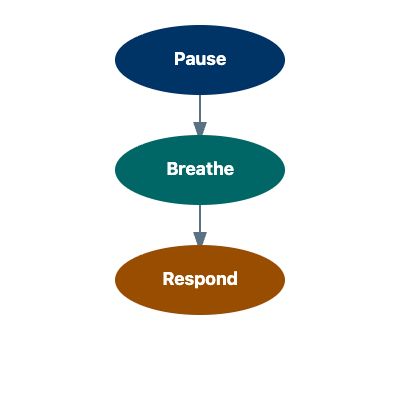When a group starts to feel tense—maybe people are raising their voices, interrupting, or looking upset—it’s easy for everyone to get pulled into the stress. But if you can stay calm, you help everyone else calm down too. This doesn’t mean you have to hide your feelings or pretend nothing’s wrong. Instead, you can use a simple “Pause, Breathe, Respond” approach:

- Pause: When you notice tension, don’t react immediately. Take a moment to stop and assess the situation.
- Breathe: Take a deep breath to calm your body and mind. This helps regulate your emotions and prevents escalation.
- Respond: Choose a thoughtful, calm response rather than reacting impulsively.
For example, if someone says, “This is so unfair! No one ever listens to me!” you might feel like snapping back. Instead, you can pause, take a breath, and respond with something like, “I can see you’re upset. Let’s take a moment and talk about what’s bothering you.” Your calm voice and steady body language (like sitting up straight, not crossing your arms, and making gentle eye contact) show others it’s safe to slow down too.
If you feel your own emotions rising, it’s okay to say, “I need a second to think before I answer.” This helps you avoid saying something you might regret. When you stay calm, others will often start to match your energy, and the group can get back to talking instead of arguing.
When people are upset, the words you choose really matter. If you use strong or blaming words, things can get worse. But if you use simple, neutral words, it helps everyone feel less attacked and more willing to listen. Let's look at some examples:
These small changes make a big difference. They help people talk about the problem, not about who’s to blame. Also, notice the “I” statements, like “I feel left out when decisions are made without me,” instead of “You always leave me out.” This keeps the focus on how you feel, not on accusing someone else.
Your tone matters too. Try to sound calm and clear, rather than sarcastic or angry. The way you say something can be just as important as the words you choose. If your voice sounds harsh, loud, or mocking, people may feel attacked or defensive, even if your words are neutral. On the other hand, speaking in a steady, even voice helps everyone feel safer and more open to finding a solution.
If you notice your voice getting tense or sharp, use the pause, breathe, respond approach from above. You can even lower your volume a little to help signal calm. Remember, your goal is to help everyone feel heard and respected, and your tone can set the mood for the whole conversation.
When people are upset, they often start thinking only about their own side. It is important to help everyone remember what they have in common and what they’re trying to do together. You can say things like, “I know we all want this to work out,” or, “We all care about having a good time together.” Reminding the group of shared goals helps everyone feel like they’re on the same team, not fighting against each other.
When you bring up shared goals, it shifts the focus from “me versus you” to “us working together.” This can help lower defensiveness and make it easier for people to listen to each other. You might also ask questions like, “What do we all want to achieve here?” or, “How can we make this work for everyone?” These questions encourage the group to think about solutions that benefit everyone, not just one person.
If the conversation gets stuck, you can suggest making a list of what’s important to each person and looking for overlap. Finding even one thing everyone agrees on, like wanting to be fair, or wanting the project to succeed, can help rebuild a sense of teamwork and move the group forward. If people are stuck arguing, try asking, “What do we all want here?” or, “How can we solve this together?” You can also help by suggesting, “Let’s list out what’s important to each of us and see where we agree.” This helps turn the argument into a problem you can all solve as a group.
Here’s how these skills look in a real conversation:
- Ryan: This isn’t fair! I always end up cleaning up after everyone, and no one even says thank you.
- Nova: That’s not true! I helped last week, but nobody noticed.
- Jake: (pauses, takes a breath) I can see we’re all frustrated. Ryan, you feel like you’re doing most of the work. Nova, you feel like your help isn’t being seen. We all want things to feel fair, right?
- Ryan: Yeah, I just don’t want to do it all alone.
- Nova: I get that. I want to help, but I also want people to notice when I do.
- Jake: How about we make a plan so everyone knows who’s helping each time? That way, it feels fair for everyone.
In this conversation, Ryan and Nova are upset about chores not feeling fair. Jake stays calm, listens to both sides, and points out that everyone wants things to be fair. By doing this, he helps the group move from arguing to working together on a solution—making a plan so everyone knows who is helping each time.
